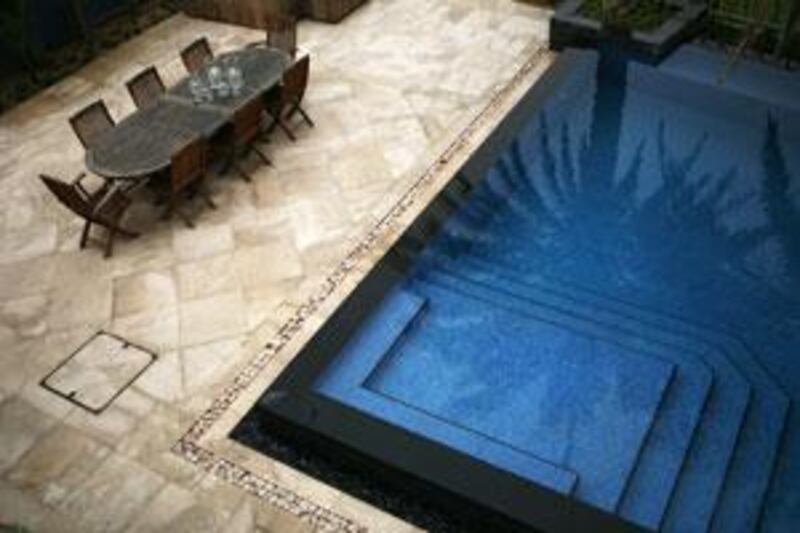For an eco-friendly, low-maintenance and elegant outdoor space, lay it out in natural stone. Despite the recent heavy rain showers that resulted in World Water Day being called off in Abu Dhabi, conserving water should still be the priority of eco-conscious gardeners everywhere, not least in this part of the world. An obvious solution is an elegant low-maintenance stone patio, to reduce the amount of irrigation as well as to blend with the arid landscape.
Nehme Moujaess, the president of Terraverde, a Dubai-based landscaping and irrigation specialist, said that there has been a growing interest in sustainable gardens, which reduce the impact on the environment. "Stone has become more popular because it enhances landscape design while also being low-maintenance and still bringing a touch of the natural," he explains. Stone areas are nothing new, indeed many gardens in the UAE are paved from corner to corner as a matter of course, with greenery added afterwards in the form of potted plants. But well designed patios are becoming increasingly popular, especially with the trend for at-home entertaining.
"Paved walled gardens with Arabian pots can look spectacular," says Annie Hayes of Stone Concepts, a specialist stone supplier in Dubai. "But there are many ways to lay stone to make interesting shapes and designs." Pre-cut stone in different sizes, or coloured grouting to highlight the different shades within the stone, can enhance even the plainest of patios, she suggests. The other benefit is that stone does not date. "I don't think natural stone ever goes out of fashion," muses Hayes. "People always want something hardwearing, pleasing to the eye, and something they can clean easily."
"[Patios] also bring the outside in," she says. "Whether as a majlis, play area or just a place to chill out. Investing in a patio is something that can add tremendous value to your home. You don't need to spend an enormous amount. Plus, stone can be a wonderful way to save money on watering your backyard." Sunil Sawlani, the managing director of Royal Gardenscape, a paving and ornamental specialist firm based in Dubai, said that many of his customers are more focused on garden decoration.
"We have definitely noticed more interest in [this]," he says. "It's not enough to just pave an area and leave it bare." Artificially weathered paving, irregular, rustic shapes and contrasting colours are all popular in residential homes. Sawlani says that pre-cut tiles are the easiest option for budget-conscious garden designers as they are easy to lay. In more highly styled spaces, landscapers are introducing different architectural planes. Individual pieces are flat and uniform, with detailing provided by smaller areas of ornamental mosaic or carving.
"Smoother surfaces are better for areas where people walk or play, although rough textures can be used as borders or accents," says Moujaess of Terraverde. "For contemporary gardens, smooth pieces align with the overall theme, whereas a more rustic garden calls for natural cut stones in earthy tones. Boulders can be placed throughout the softscape or can be stacked near a pool with an added waterfall option. Smaller stones could be used to line pools and create borders."
For the searing heat of the UAE sun, lighter coloured stone is preferable, explains Sawlani. "Lighter shades - beige, pink, grey and yellow - blend easier with the colouring of the house. [But] although aesthetics are a factor, lighter colours are practical: they won't heat up as much under the glare of the summer sun." "Lighter colours definitely suit this climate better," agrees Hayes, suggesting slate quartzites, dense sandstone, limestone and travertine, as well as granites. Pale sandstone is also an option but Hayes cautions against laying the wrong kind outdoors. "Some sandstones are not really suited for this area as the region lies on very salty table water. The more porous the stone, the more it soaks up the salt and you end up with whitish markings on your sandstone."
Ivan Nowrouzi the managing director of Stoneville, a UK-based stone exporter, says a less porous stone is vital for this region. "It's important to choose a stone that is hard-wearing. For areas that are more likely to be used frequently, basalterra (the hardest wearing type of basalt) is much harder than travertine or sandstone, and travertine is a good choice for residential areas as it is durable and comes in a variety of colours," he advises.
Resilient and beautiful, travertine is sourced from various countries including Italy, Iran, China and Jordan and, because of this, it's widely available. Travertine is trendy, says Hayes, and is "a fabulous look for internal and external flooring". "A lot of our clients are using polished or honed travertine for their interior flooring and carrying the look outside with brushed-finish travertine around the pool area."
Travertine is a natural stone that is characterised by earthy tones. It gives a warm, aged look and each stone is unique. "The popularity of travertine is an excellent reflection of the trend for lighter, neutral colours that blend easily with any décor," says Moujaess. A patio can be an economic and aesthetically pleasing way of making your house more friendly to your guests as well as the environment.





